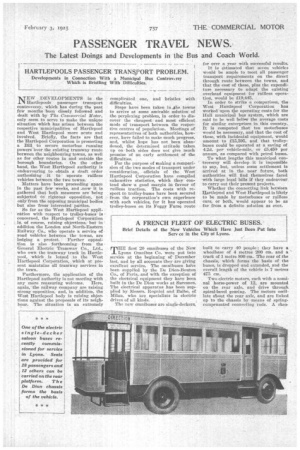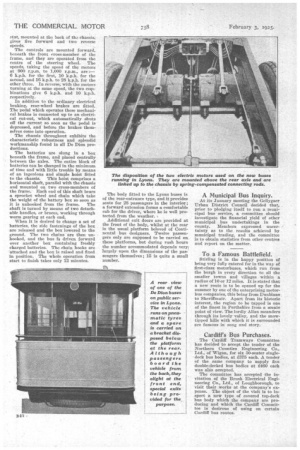A FRENCH FLEET OF ELECTRIC BUSES..
Page 23

Page 24

If you've noticed an error in this article please click here to report it so we can fix it.
Brief Details of the New Vehicles Which Have just Been Put Into Serv ce in the City of Lyons.
THE first 20 omnibuses of the New Lyons Omnibus Co. were put into service at the beginning of December last, and by all accounts they are giving excellent service. The omnibuses have been supplied by the De Dion-Bonton Co., of Paris, and with the exception of the electrical equipment they have been built in the De nonworks at Suresnes. The electrical apparatus has been supplied by Messrs. Rognini and Balbo, of Milan, who -are specialists in electric drives of all kinds.
The new omnibuses are single-deckers,
built to carry 40 people ; they have a wheelbase of 4 metres 200 cm. and a track of 1 metre 800 cm. The rear of the chassis, which forms the basis of the buses, is dropped and extended, and the overall length of the vehicle is 7 metres 475 cm.
Two electric motors, each with a nominal horse-power of 12, are mounted on the rear axle, and drive through spiral-bevel gearing. The motors oscillate fttout the rear axle, and are linked up to the chassis by means of springcompensated connecting rods. A rhea.
stat, mounted at the back of the chassis, gives five forward and two reverse speeds.
The controls are mounted forward, beneath the front cross-member of the frame, and they are operated from the centre of the steering wheel. The speeds, taking the speed of the motors at 900 r.p.m. to 1,000 r.p.m., are:6 k.p.h. for the first, 10 k.p.h. for the second, and 16 k.p.h. to 28 k.p.h. for the other three. In reverse, with the motors turning at the same speed, the two copbinations give 6 k.p.h. and 10 k.p.h. respectively.
In addition to the ordinary electrical braking, rear-wheel brakes are fitted. The pedal which operates these mechanical brakes is connected up to an electrical cut-out, which automatically shuts off the current so soon as the pedal is depressed, and before the brakes themselves come into operation.
The chassis throughout exhibits the characteristic robustness and splendid workmanship found in all De Dion productions.
The batteries are slung in a box beneath the frame, and placed centrally between the axles. The entire block of batteries can be changed in the minimum of time and with little trouble by means of an ingenious and simple hoist fitted to the chassis. This hoist comprises a horizontal shaft, parallel with the chassis and mounted on two cross-members of the frame. Each end of this shaft bears a sprocket wheel and chain which take the weight of the battery box so soon as it is unhooked from the frame. The shaft is turned by means of two detachable handles, or braces, working through worm gearing at each end.
When it is desired to change a set of batteries, the side fastenings of the box are released and the box lowered to the ground. The two chains are then unhooked, and the bus is driven forward over another box containing freshly charged batteries. The chain hooks are attached and the box is raised and fixed in position. The whole operation from start to finish takes only 12 minutes. The body fitted to the Lyons buses is of the rear-entrance type, and it provides seats for 28 passengers in the interior ; a forward extension forms a comfortable cab for the driver, where he is well protected. from the weather.
Additional exit doors are provided at the front of the body, whilst at the rear is the usual platform beloved of Continental bus designers. Twelve passengers only are supposed to be carried on these platforms, but during rush hours the number accommodated depends veryi largely upon the dimensions of the passengers themselves; 15 is quite a small number.
A Municipal Bus Inquiry.
At its January meeting the Gellygaer Urban District Council decided that, . prior to pledging itself to run a municipal bus service, a committee should investigate the financial yield of other municipal bus undertakings in the county. Members expressed uncertainty as to the results ,achieved by municipal trading, and the committee is to obtain statistics from other centres and report on the matter.
To a Famous Battlefield.
Stirling is in the happy position of being very fully catered for in the way of first-class motorbuses, which run from the burgh in every direction to all the smaller towns and villages within a radius of 10 or 12 miles. It is stated that a new route is to be opened up for the summer by one of the enterprising motorbus companies, this being from Dunblane to Sheriffmuir. Apart from its historic interest, the region to be tapped is one of the finest in Perthshire from a scenic point of view. The lordly Allan meanders through its lovely valley, and the snowtipped hills with which it is surrounded are famous in song and story.
Cardiff's Bus Purchases.
• The Cardiff Tramways Committee has decided to accept the tender of the Northern Counties Engineering Co., Ltd., of Wigan, for six 30-seater singledeck bus bodies, at £375 each. A tender of the same company to supply five double-decked bus bodies at £460 each was also accepted.
The committee has accepted the invitation of the Brush Electrical Engineering Co., Ltd., of Loughborough, to visit their works at the company's expense. The object of the visit is to inspect a new type of covered top-deck bus body which the company are producing and which the Cardiff Committee is desirous of using on certain Cardiff bus routes.




























